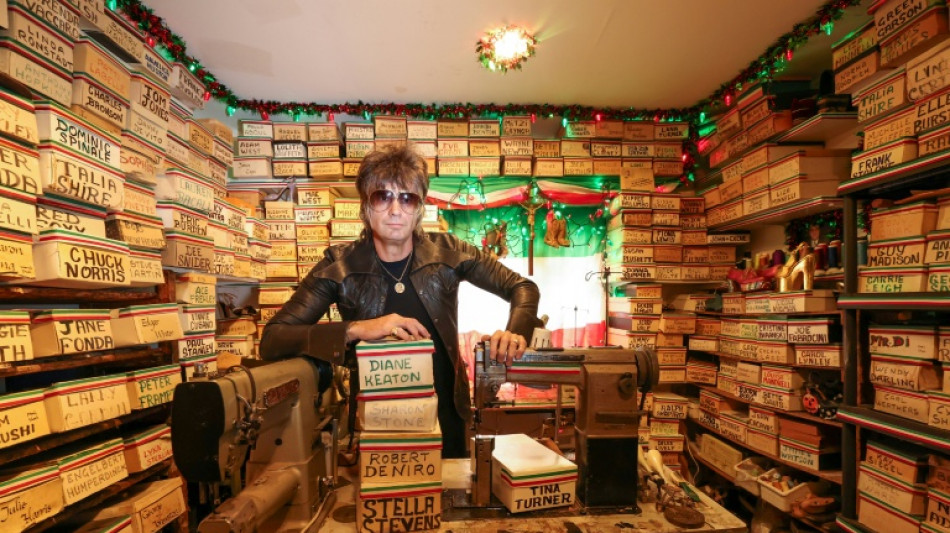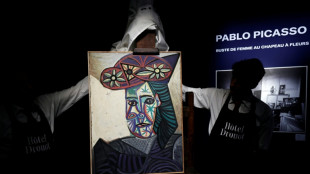
LA shoemaker holds Hollywood's past in a dying art

In a cobbler's workshop in Los Angeles, the footprints of Hollywood history are stacked floor to ceiling, watched over by a man who says his profession is dying.
Yellowing boxes hold the lasts -- foot-shaped molds -- used to create footwear for everyone who was anyone in America's entertainment capital for more than half a century.
Elizabeth Taylor lies toe-to-toe with Peter Fonda, Tom Jones and Harrison Ford.
In another stack sit the lasts for Sharon Stone, Liza Minnelli and Goldie Hawn.
Action heroes Sylvester Stallone and Arnold Schwarzeneggar are also present.
"There's a bit of everybody here," says shoemaker Chris Francis, the custodian of the famous feet molds.
Francis came into the collection a few years after the 2008 death of Pasquale Di Fabrizio, an Italian cobbler known in Los Angeles as the "shoemaker to the stars."
"Di Fabrizio made for everyone, from the casino owners to the actors, the performers in Vegas, Broadway, Hollywood, for film -- just anybody you could think of who was performing from the 1960s until 2008."
Some of the aging boxes contain autographs or dedications from the A-listers.
Others, like those of Sarah Jessica Parker or "Sound of Music" songstress Julie Andrews, hold drawings from television or film productions.
- 'Something that nobody else had' -
Hollywood was once the ideal place for a shoemaker, says Francis, with its voracious creative industry that churned out a constant stream of people who needed to make themselves stand out from the crowd.
"Celebrities would brag about how much they paid for a pair of shoes, and they would want something that nobody else had," he said, pulling down a box containing the lasts of Adam West, the actor who played Batman in the original 1960s TV series.
Francis began his own couture journey making clothes, and was given his first gig after being discovered stitching a leather jacket on a park bench.
"Here in LA, it is easy to be in the right time in the right place," he laughed.
But it was footwear that he really wanted to create, and began practicing in his kitchen at home.
"They were sort of crude at first; I was just teaching myself how to do it," he said.
In search of someone to teach him the art, Francis traipsed around Los Angeles looking for an internship.
"These guys are all old Armenian, Russian guys. They're all from like the old world -- guys from like Iran, Syria.
"They wouldn't talk, or they didn't speak very good English. So you just have to watch and learn, and then just learn by making over and over and over again."
And if you don't pay attention, it can all go wrong, he said.
"There's no forgiveness in a shoe. If you miss a step, if you cut a corner, then the next 20 steps after that might suffer. So everything has to be on point the whole time."
- Mass production -
But in a changing world, such meticulous craftsmanship is not always rewarded.
Where Burt Reynolds or Robert De Niro might once have been happy to shell out thousands of dollars for a pair of handmade shoes, the whole industry has been turned on its head.
"I'm finding more and more celebrities wanting shoes for free, which is just killing shoemakers like me," said Francis.
With his aging rockstar looks, Francis says in darker moments he wishes he had taken the advice of some of the old cobblers who taught him the trade.
"They told me to go join a band," he said.
"When I first started, (one man) said: 'Why in the world do you want to be a shoemaker? They can buy shoes for $20 these days.'"
Francis, 48, says some of the old-time shoemakers have given up trying to create footwear from scratch, and now just fix the mass-produced shoes that have put them out of business.
"As a profession, it's extremely difficult to survive," he says.
F.Criscuolo--INP

 London
London

 Manchester
Manchester
 Glasgow
Glasgow
 Dublin
Dublin
 Belfast
Belfast
 Washington
Washington
 Denver
Denver
 Atlanta
Atlanta
 Dallas
Dallas
 Houston Texas
Houston Texas
 New Orleans
New Orleans
 El Paso
El Paso
 Phoenix
Phoenix
 Los Angeles
Los Angeles



